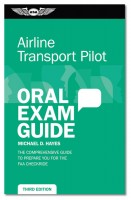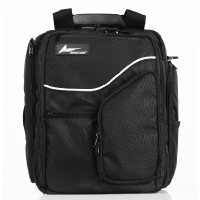Turbine Pilots Flight Manual - Fourth Edition
 Softcover Book
Softcover Book eBook EB
eBook EB eBook PD
eBook PD eBundle
eBundleOverview
|
Everything a pilot is expected to know when transitioning to turbine-powered aircraft
Whether you’re preparing for turbine ground school, priming for a corporate or airline interview—or even if you’re upgrading into your first personal jet or turboprop—The Turbine Pilot’s Flight Manual is designed for you. With precision and a sense of humor, authors Greg Brown and Mark Holt cover all the basics for turbine pilot operations, clearly explaining the differences between turbine aircraft and their piston engine counterparts. This manual clarifies the complex topics of turbine aircraft engines and all major power and airframe systems, subjects that are pertinent to flying bigger, faster, and more advanced aircraft. It includes discussions on high-speed aerodynamics, automation, wake turbulence, coordinating multi-pilot crews, navigating in high-altitude and adverse weather, air carrier operations, transport airplane performance, and professionalism and leadership development. You’ll be introduced to state-of-the-art cockpit instrumentation including flight management systems (FMS), global navigation (GPS), and head-up guidance systems (HGS or HUD). You’ll also learn the operating principles of hazard avoidance systems, including weather radar, ground proximity warning systems (EGPWS), and predictive wind shear systems (PWS), as well as navigation (RNAV/RNP), advanced communication procedures and equipment (datalink and ADS-B), and the latest engine performance management techniques (such as reduced vs. derated thrust). This fourth edition adds dozens of additional illustrations and updates in technology and terminology required for completion of an Airline Transport Pilot Certification Training Program (ATP-CTP). Included are an updated glossary of airline and corporate aviation terminology, handy turbine pilot rules-of-thumb, and a comprehensive turbine aircraft “Spotter’s Guide.” The authors clarify these complex topics with a wealth of illustrations, and additional information is available online making these systems easier than ever to understand. |
Specifications
- Authors: Greg Brown and Mark Holt
- ISBN: 978-1-61954-919-7
- Edition: Fourth Edition
- Dimensions: 8.25" x 10.75"
- Page Count: 400 pages
- Illustrations: Full-color and black-and-white illustrations throughout
- Includes:,Glossary, index, aircraft "spotter's guide"
- Weight: 1.40 lbs
- eBundle / eBook
- ASA eBooks are for one person's use and can be read on up to five devices total using e-reader applications that are compatible with an Adobe ID. To read eBooks on more than one device, the e-reader applications on those devices must be authorized with your Adobe ID.
- To create an Adobe ID, or to recover lost or forgotten ID information like your login or password, (Click Here)
Version Types
eBook PD - A protected document that looks identical to its print book counterpart. Exact formatting and layout of the print books is maintained (text, images, margins, page breaks, etc.). Displays best on 10-inch or larger screens. Not recommended for small screens (phones) which require you to zoom in and pan around to see the full page. This document is not a .pdf file type. It is a .acsm file type. See http://asa2fly.com/use-ebooks for more details on how to setup your device.
Softcover Book - Printed book with heavyweight cover stock.
eBook EB - A protected document designed for reflowable content. Also referred to as an ePub or "Electronic Publication" format. Easily viewed on both small and large screens. Text, images, and pages will adapt or reflow to fit the screen size of the device, so zooming is not necessary to read. Text size can be adjusted in an ebook reader app. Visit http://asa2fly.com/use-ebooks for more details on how to setup your device.
eBundle - Includes both the print book and eBook PD.
Q&A
Please note, Aircraft Spruce's personnel are not certified aircraft mechanics and can only provide general support and ideas, which should not be relied upon or implemented in lieu of consulting an A&P or other qualified technician. Aircraft Spruce assumes no responsibility or liability for any issue or problem which may arise from any repair, modification or other work done from this knowledge base. Any product eligibility information provided here is based on general application guides and we recommend always referring to your specific aircraft parts manual, the parts manufacturer or consulting with a qualified mechanic.





































